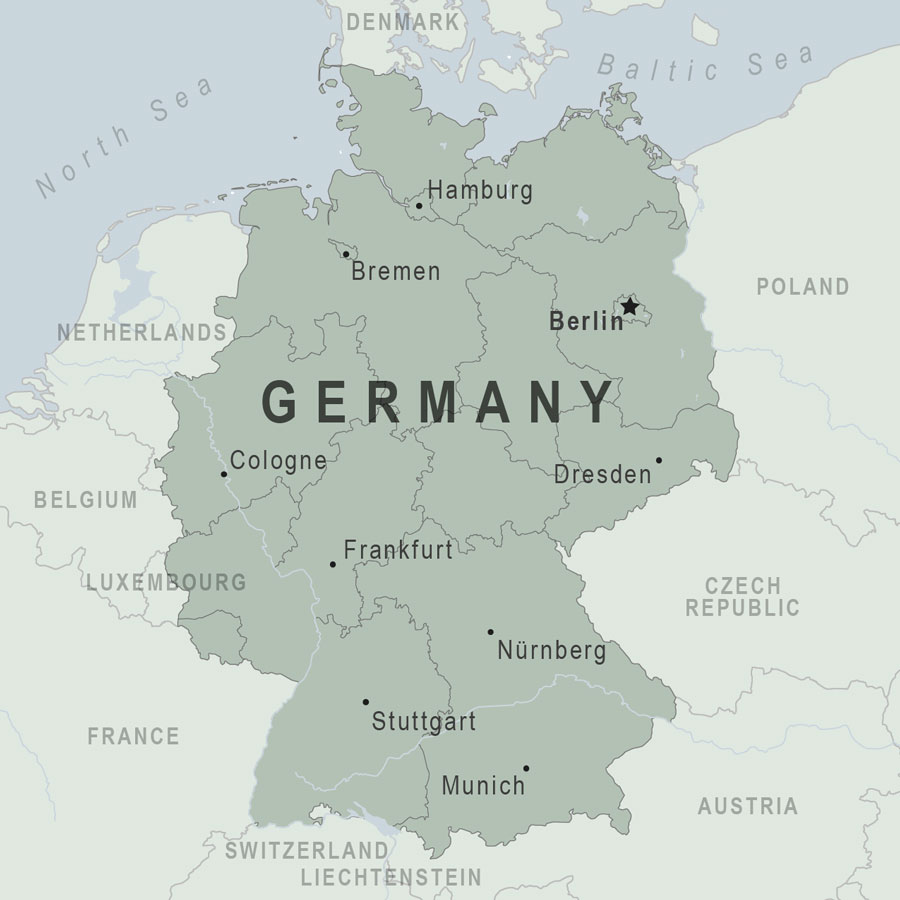
Five Quick Points About Germany
- Germany is the 6th largest study destination for international students worldwide
- Degrees are internationally compatible
- Emphasis on applied sciences, interdisciplinary studies, international outlook, and theory balanced with practical applications
- Very green, environmentally aware society
- Blend of modern and traditional cultures
Location and Geography

Germany (Deutschland), the sixth largest country in Europe by land area (349,520 square kilometres), is situated in central Europe, with coastal access to the North and Baltic Seas. It is bordered by nine other European countries to the north, east, south, and west. It comprises lowlands (north), uplands (centre), and the Bavarian Alps to the south. Berlin (in the northeast) is the capital.
The climate of Germany is temperate (and marine in the north), with cool, cloudy, wet winters and warm summers, occasionally tempered by the Föhn, a warm mountain wind. There can be marked variations in climate from region to region.
Economy of Germany
Germany is a member of the European Union (EU). Its economy is the largest in Europe and the fourth-largest in the world after the U.S., Japan, and China, and it is very export-oriented (second-largest exporter in the world). It is among the largest and most technologically advanced producers of iron, steel, coal, cement, chemicals, machinery, vehicles, machine tools, electronics, food and beverages, shipbuilding, and textiles. It is the leading producer of wind turbines and solar power technology in the world.
Some of the largest annual international trade fairs and congresses occur in German cities such as Hanover, Frankfurt, and Berlin. The currency is the Euro.
Living Conditions and Cost of Living
International students living in Germany can generally live on €750–€950 a month. Most public universities do not charge tuition for international students, although some states do have policies in place for international student fees – please check with the individual institution to make sure about its tuition policies. If they attend a private university, students can expect to spend €20,000 a year in tuition. Health insurance is usually around €50–€60 a month.
Education System
The fundamental structure of the German education system is similar to that of many Western countries. It consists of elementary (primary), secondary (lower and upper) and tertiary/higher education. It is in the detail – especially in relation to the range of institutions that deliver tertiary/higher education – where the differences lie. International students planning to study in Germany need to be able to identify these differences in tertiary/higher education
Most of these institutions are public (government). There are some privately run institutions; however, public education is the first choice for most (more than 90%).
Information Specific to International Students
Close to 325,000 international students are enrolled at German institutes of higher education. This makes Germany among the most sought-after destination countries in the world.
There is a German language proficiency requirement for entry to higher education institutions, the DSH (DSH-Prüfung). In some situations, basic language may be accepted dependent upon the course, the level of study, and the language of instruction. German-language courses are available at most institutions.
Non-EU students may need to obtain a student visa prior to entering Germany. Students should first check with the German embassy or consulate in their own country to obtain the most up-to-date information about student visa requirements. Visa application processing for long-stay visas can take several months, so students must allow sufficient processing time prior to their intended date of entry. Students who wish to seek work while studying need to check if they will need a work permit. International students can work while they study in Germany, and because student jobs are subsidised (entailing lower social security costs for employers), many German employers find student workers an attractive option.
